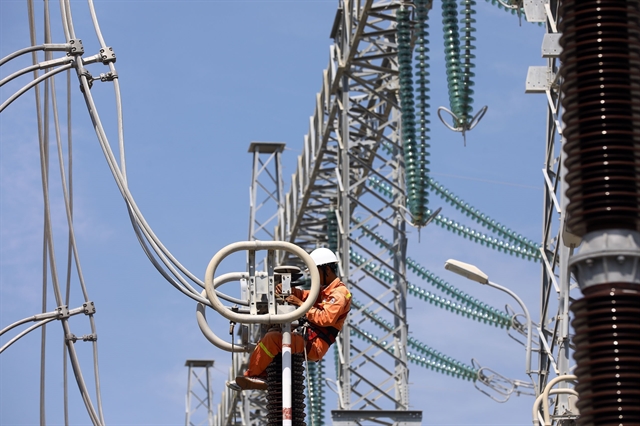 Society
Society


|
| A worker maintains circuits at a 500kV electrical substation in Bình Thuận Province. The third 500kV circuit would serve to transmit excessive power in the Central Region to the Northern Region. — VNA/VNS Photo Huy Hùng |
HÀ NỘI — The government has long recognised the pivotal role that electricity plays in socio-economic development and macroeconomic stability, adhering to the principle of "electricity comes first" when charting its agenda.
That was the remark made by Nguyễn Đức Kiên, former Vice Chairman of the National Assembly's Economic Committee, at the workshop "Electricity Supply in 2024: Urgent Issues" on Tuesday.
Kiên said the government had spared no efforts in accelerating the construction of power plants since 2021 to keep power shortage at bay.
In 2022, the Prime Minister demanded the operation of plants whose inauguration had been delayed for quite some time, including Sông Hậu 1 Thermal Power Plant and Thái Bình 2 Power Plant. As a result of the instruction, the two plants finally came online in early 2023.
In 2023, the PM pressed ahead with another instruction to expedite the construction of the third 500kV circuit, which serves to transmit excessive electricity in the Central Region to the Northern Region to smooth out power supply across regions.
"Those activities indicate that the government takes electricity supply really seriously," said Kiên.
The vice chairman also said a one per cent increase in GDP would require a 1.5 per cent increase in electricity output. That means the target of an annual GDP growth rate of 7 per cent would carry with it a colossal need for electricity.
He suggested the government factor transmission costs into the total costs estimated by the Power Development Plan VIII to cover the full costs incurred by electrical circuits, especially the 500kV one.
Bùi Xuân Hồi, Head of the Northern Power College, said power shortages, in theory, cannot happen because Việt Nam generates electricity at a capacity of 80MGW, far higher than the demand of 40MGW. However, the reality is quite different.
The problem lies in the composition of the power output: of the 80MGW, about 20MGW comes from solar and wind farms that normally go offline when the sun goes down at 6 pm. That means 80MGW is the installed capacity; the actual capacity that can be reliably used is much less than that, resulting in power shortages sometimes.
However, the government has taken measures to ensure no more power shortages in 2024. The measures centre around the inauguration of new power plants in the short term and the transmission of excessive power in the Central Region to the Northern Region to pick up the slack.
Hồi called for a new approach to the calculation of feed-in tariffs (FiT) to attract more renewable energy investors in the Northern Region. He said FiT was calculated based on solar irradiance, which had incentivised investors to concentrate their efforts in highly-irradiated regions and neglect others.
A new approach, he believed, would help distribute solar and wind farms more evenly across the country, adding to the electricity output in the Northern Region.
Economic expert Ngô Trí Long said under the price management mechanism, there are three categories of electricity price that apply to production activities, administrative activities and household use.
He said the public had raised its voice over the practice of keeping electricity prices on production activities low by subsidies. While low prices could help reduce production costs and improve competitive advantages, they also discouraged the transition to power-efficient technologies among producers.
He called for a two-category mechanism for electricity prices and underlined the need for a clear-cut separation between electricity for public use and for production activities. — VNS




